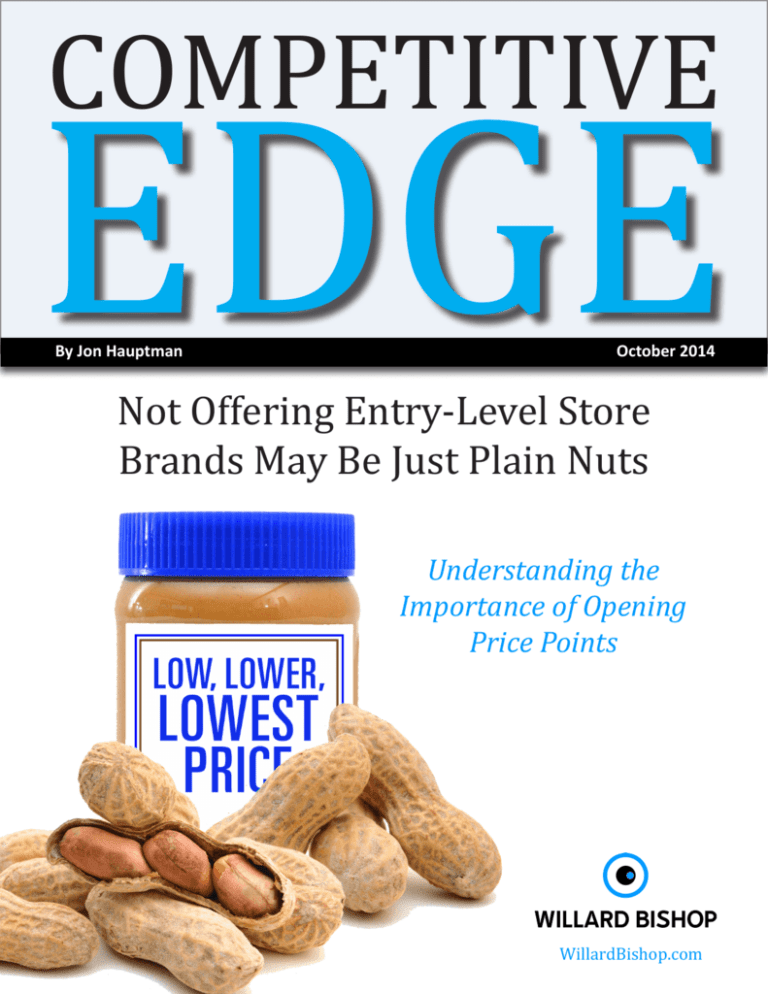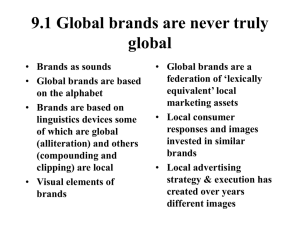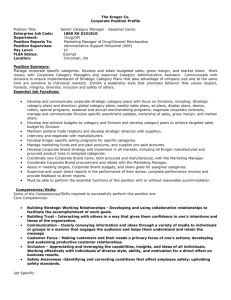
COMPETITIVE
EDGE
By Jon Hauptman
October 2014
Not Offering Entry-Level Store
Brands May Be Just Plain Nuts
Understanding the
Importance of Opening
Price Points
WillardBishop.com
The upcoming PLMA (Private Label Manufacturers Association) show will undoubtedly be buzzing around pricing.
After all, price is private label’s most important competitive platform. But this year’s event, being held in Chicago,
November 16-18, will likely focus on extreme value price
points connected to entry-level store brands. These emerging econo-brands, once considered private label’s ugly kid
sister, are becoming highly coveted offerings for shoppers
and retailers.
Kroger and Walmart are embracing entry-level store brands and
opening price points to protect their market share and communicate value.
Some things are simply better together
Kroger and Walmart have discovered that entry-level
brands do provide value when properly positioned within
their store brands’ portfolio. While many retailers may feel
entry-level products promote downward trading, Walmart
and Kroger are proving that their private label (national
brand equivalents) and their entry-level offerings are better together.
Elevating Entry-Level Store Brands for Competitive Differentiation
The importance of entry-level store brands is being driven by four key factors:
1. Stagnant sales in supermarkets
2. Competition from non-traditional formats
3. Reductions in government benefits
4. Improper positioning of private label (national brand equivalents)
1. Stagnant sales
4. Improper positioning of private label
Most grocery retailers are experiencing flat-to-declin-
Retailers without entry-level store brands are requir-
ing same-store sales, and are actively looking for new
ing their mainstream private label brands to play
ways to differentiate their banners in order to recap-
a dual role. Their national brand equivalents must
ture lost shares.
serve as an acceptable alternative to national brands
by providing attractive, not overwhelming, savings.
2. Competition from non-traditional formats
These store-branded goods must also serve as the
Traditional supermarket sales are being lost to limited
opening price point within the product’s category.
assortment stores such as Aldi, PriceRite, and Save-
This dual role forces retailers to underprice their store
A-Lot. Extreme value stores, such as Dollar General,
brands and accept lower margins.
Dollar Tree, and Family Dollar, are also growing at
the expense of traditional grocers. According to Wil-
In response to these market dynamics, Kroger and
lard Bishop’s annual Future of Food Retailing report,
Walmart have increased their focus on entry-level
these formats now account for 5.2% of retail food
store brands. By doing so, they enhance their price-
sales. Share for these formats may climb to 6% over
value image, drive sales growth, and help shoppers
the next five years. Both formats are driving competi-
extend their grocery dollar - all while staving off com-
tive advantage through low, opening price points, and
petition from limited assortment and dollar store re-
traditional retailers are taking notice.
tailers.
3. Reductions in government benefits
In November of last year, the SNAP/Food Stamp benefit boost created by the American Recovery and Reinvestment Act of 2009 ended, thereby reducing the
allocations of food stamps. Consequently, millions of
households began looking for new ways to stretch
their grocery budgets.
Kroger and Walmart Reinvent Entry-Level Offerings
Industry-wide sales of store brands account for approximately 20% of total sales. However, Kroger’s percent of
sales from its store brands is an industry-leading 25%. While Kroger was a pioneer in entry-level store brands
with its Kroger Value line, they recognized that the offering was in need of refreshing.
Earlier this summer, Kroger rolled out three new entry-level store brands to replace Kroger Value and to bring
low-price options to a larger number of categories. Their expanded entry-level brands now include:
• Psst, for center-store food categories
• Check This Out, for non-food categories
• Heritage Farms, for fresh categories
These items appeal to shoppers with attractive packaging, appealing brand names, and of course, prices.
Kroger is proving that staid generics have been supplanted by new, budget-friendly alternatives.
Walmart has historically relied on its Great Value and Equate brands to satisfy the budget-seeking shopper.
However, they recognize that lower-priced options are available elsewhere, therefore a response was warranted in order to retain its position as America’s low-priced leader.
Consequently, Walmart launched a new line of opening price point items under the Price First brand, which
complements their national brand equivalent products.
Price First is destined to shake up the store brand and
value retailing industries; however, Price First is currently
limited to approximately 50 SKUs. But given the
focus placed on entry-level store brands by Kroger, we
expect Walmart to aggressively enhance their entrylevel offerings.
A Necessary Offering
Some retailers appear hesitant to embrace entry-level, opening price point store brands. They fear these products will not sell enough to warrant their space on the shelf, and that their availability will encourage shoppers
to “trade down,” thereby reducing sales and margin.
However, entry-level store brands are a necessary part of every retailer’s price-value offering. They comprise one
of the “Six Dimensions of Price Image”, accompanied by everyday base prices, promotional offerings, knownvalue item prices, merchandising, and price communication. To ensure a strong
price image, retailers need
a strong position in each of
the six dimensions. Weakness in even one dimension
compromises the chain’s
overall price-value offering.
Consequently,
refocusing
on entry-level store brands
is
critically
While
important.
entry-level
store
brands contribute only 2-5% of most retailer’s private label sales, their sales are growing quickly in an environment where sales are flat. Their presence also encourages consumers to shop the store more intensively since
budget-stretching options are available in categories that attract the specific buyers.
Entry-level store brands are one way retailers can improve price image without lowering prices. They represent
an opportunity to strengthen image by having the right variety of value-oriented items, and provide recognizable
savings. Their importance extends well beyond their sales contribution. Just having them in the set increases
total basket size since shoppers know they don’t have to travel elsewhere in order to capture the best values in
town.
Kroger’s commitment to their entry-level store brand offering is one way they are neutralizing Walmart’s price
advantage. While Kroger may not be able to match Walmart prices on all items across the store, they are successfully providing value options through entry-level store brands.
Last month Willard Bishop conducted a study of opening price point values across 112 consumables categories in one Midwestern market. The study found Kroger’s best value offering
to be, on average, two percent lower than Walmart’s best value offering.
The Right Response
Unfortunately, many traditional supermarkets are not taking entry-level store brands seriously and find themselves with unflattering price-value images. It’s not uncommon to see traditional, full-service supermarkets with
national brand prices that are 5%+ higher than Kroger and 15%+ higher than Walmart. However, “best value” offerings are often 30-35% higher because the traditional supermarket retailer does not have an adequate variety
of opening price point store brands.
Retailers are encouraged to take a fresh look at entry-level store brands. Retailers should work with their wholesalers and/or store brand suppliers to ensure a strong offering (measured on a price-per-ounce/pound basis) is
provided in every major consumables category. These items will provide shoppers with budget-stretching options, and will combat competitive pressures.
To learn more about the value of opening price points and
private label strategies, please contact Jon Hauptman at
847.756.3714 or jon.hauptman@willardbishop.com.
About the Author
Jon Hauptman | Partner
Jon, a widely recognized pricing expert and retail strategist, leads the Willard
Bishop retail services practice. In addition to developing innovative retail services
and solutions, Jon is an accomplished speaker and frequently serves as a guest
panelist for the retail industry. Jon is also featured regularly in major media venues such as The Wall Street
Journal, USA Today and National Public Radio.
Prior to joining Willard Bishop, Jon served in marketing roles with United Airlines and Dominick’s Finer
Foods. Jon holds an M.B.A. from the University of Chicago.
Want Willard Bishop to address a specific retail or CPG issue in an upcoming Competitive Edge?
If so, send a request to jeff.rice@willardbishop.com stating your challenges, issues or ideas.
The Willard Bishop editorial staff will review all submissions and notify you if your topic is selected.
This document may be shared freely.
Copyright © Willard Bishop, 2014. All rights reserved.
PRODUCTS
AD-IN™, developed by Willard Bishop and
Willard Bishop, with nearly 40 years of experience in
consumer packaged goods (CPG) and food retailing,
has earned the reputation as the industry’s preeminent
consulting firm. The company’s rich history is steeped in
delivering high-impact, high-value solutions across the
CPG value chain.
Today, Willard Bishop continues to enhance the performance of its clients by using advanced analytics and superior
insights to create game-changing outcomes.
Willard Bishop provides a solution matrix that combines
expert knowledge and insight with custom-developed
applications and tools, to improve client performance –
from concept to consumer.
Willard Bishop practice areas include:
• Activity-Based Costing
• Retail Pricing/Promotion
• Localization Strategies
• Shopper Relevancy
• eCommerce
• Channel Development
• Collaborative Performance
• Product Positioning
840 South Northwest Highway
Barrington, Illinois 60010
847.381.4443 | 847.381.3588 Fax
www.willardbishop.com
Prognos, is the first promotion productivity tool
that optimizes the collective performance of a
retailer’s circulars and TPRs in order to gain
margin and
increase visits.
The Total Store SuperStudy™ (grocery)
is a product performance benchmarking tool,
created using 52 weeks of performance data
from top retailers in the U.S. SuperStudy™
subscribers use this proprietary, aggregate data
(available at total store, department, category,
and subcategory levels) to make better decisions
based on key financial metrics, including cost of
goods, trade monies, margins, unit volume,
profitability, ROI, and other financial performance measures. Customization of SuperStudy™
data, to the brand level for example, is also
available.
The Convenience Store SuperStudy™
is a benchmarking and basket analysis tool used
to improve decision making, and for developing
fact-based performance initiatives. The 2014
SuperStudy™ includes all key packaged goods
and food service categories, as well as subcategories, across three leading c-store chains.
The Localization Study™ is comprised of
60 million shoppers across select retailers in
25 states. The study is used by retailers and
manufacturers to extract actionable insights
from the study’s transactional data, which spans
1,400 stores over a 104-week period. Subscribers use the Localization Study™ to analyze
category performance, customer behavior, and
merchandising effectiveness.








